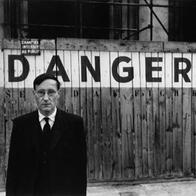CUT-UPs
compiled by Colin Fallows
 Brian Gysin - Cut-Ups Self-Explained (1960 - 1962)
Brian Gysin - Cut-Ups Self-Explained (1960 - 1962)
 William S. Burroughs - Are You tracking Me? (1965)
William S. Burroughs - Are You tracking Me? (1965)
A
COPY OF THIS PROGRAM CAN
BE ORDERED FROM THE "ORF
TONBANDDIENST"
| Colin
Fallows, artist, curator and Professor of Sound and Visual Arts at
Liverpool John Moores University, has curated a special selection of
rare recordings on the theme of Cut-ups. The programme features an
explanation of the cut-up method by Brion Gysin and a major work by
William S. Burroughs employing various types of the cut-up method,
including creative uses of radio. The programme coincides with the exhibition “Cut-ups, Cut-ins, Cut-outs: The Art of William S. Burroughs”, curated by Colin Fallows at the Kunsthalle Wien, 15 June – 21 October 2012. Assembling Burroughs’ cut-ups in such different media as text-image collages, photo-montages, audio-tape experiments and film, together with the legendary shotgun paintings, the exhibition highlights the cross-over character of his oeuvre, which has influenced wide areas of pop culture, art, music, and techniques of digital sampling. William Burroughs became friends with the artist Brion Gysin in 1958 and it was Gysin who discovered, or re-invented the cut-up method by chance in Paris in October 1959 when he was using a Stanley knife to cut mounts for his watercolours. The blade cut through the layers of newspapers used to protect his desktop and as the sections of newsprint peeled away he recognised that by reading the different sections of paper from different layers new texts could be created from what was already there. He began moving the fragments together to compose new phrases and sentences and a few days later showed the discovery to William Burroughs. Burroughs immediately recognised that this was a tool of great importance to him and established a new form of writing: the cut-up method – whereby text and image fragments are intuitively pieced together to form open associative narrative structures in order to expand the boundaries of language and describe human consciousness. He extended this method into sound and the visual arts producing a large body of work in various forms. The cut-up collage concept, with its roots in Dada, released Burroughs from the constraints of linear narrative. The programme opens with a recording of Brion Gysin reading ‘Cut-Ups Self-Explained’ (c. 1960-1962), released on the British Library CD ‘William S. Burroughs and Brion Gysin’ (2012) to coincide with the exhibition at the Kunsthalle Wien. The piece includes Gysin’s famous dictum, ‘writing is fifty years behind painting'. Gysin’s chance discovery, or re-discovery, of the cut-up method was an extension of the ideas expressed by Tristan Tzara in ‘To Make a Dadaist Poem’ (1920). Gysin knew the work of the Dada artists from the 1930s, having exhibited with a number of them in 1935. Burroughs and Gysin were also familiar with the work of Tzara and his Dada contemporaries through Robert Motherwell’s anthology The Dada Painters and Poets (1951), and Burroughs recognised other antecedents such as T.S. Eliot’s The Waste Land (1922) and John Dos Passos’s USA trilogy from the 1930s. Gil J. Wolman also developed cut-up methods as part of his Letterist work in the 1950s. But it was a major revelation to Burroughs when he saw Gysin demonstrate the creative method in action. Artist: Brion Gysin Title: Cut-Ups Self-Explained Date of recording: c. 1960-1962 Duration: 3.50 From: William S. Burroughs and Brion Gysin British Library, NSACD111 London, 2012 [CD] The second part of the programme features one of Burroughs’ most ambitious soundworks using the cut-up method. The piece entitled ‘Are You Tracking Me?’ (1965) was recorded in New York and combines radio cut-ins with a track of Burroughs reading from his work. The frequently changed radio stations pause occasionally on static or Morse-code type sounds as they switch from English language news and music stations through German and Hispanic stations. Occasionally, Burroughs’ cut-ins respond to the radio announcer. The piece also contains readings from an English as a foreign language course, alluding to the issues inherent in language and communication. The combination of popular music, news reports, advertisements and collage fragments from Burroughs’ own short stories creates an intriguing soundscape on the theme of communication in mid-1960s America. The piece concludes with Burroughs scrolling through short-wave transmissions, international languages and radio static. Artist: William S. Burroughs Title: Are You Tracking Me? Date of recording: 1965 Duration: 44.30 From: William S. Burroughs: Real English Tea Made Here Audio Research Editions, ARECD301 Liverpool, 2007 [3 x CDs] Many of Burroughs’ key soundworks using the cut-up method are collected on the 3CD- set ‘Real English Tea Made Here’ (2007) with the works providing a valuable insight into Burroughs' methodology and documenting his expansion from cut-ups on paper to vocal permutations and sonic experimentation. Many of the tape works were originally created in Tangier and New York in the early 1960s using reel-to-reel analogue tape, sound-on-sound technology. Many later pieces (now lost) were recorded by Burroughs in 1965 in Paul McCartney's small experimental recording studio in Montagu Square, London, managed by Burroughs’ friend Ian Sommerville. Burroughs was a frequent visitor and watched as McCartney put together Eleanor Rigby there. McCartney in turn, learned all about cut-ups. The extensive exploration of the cut-up method by Burroughs in its many variations opened up new methods of writing and creating soundworks inviting a variety of possibilities for future artists. He made cut-up tapes and audio assemblages before multi-track sound collage became a veritable mode of artistic expression. Link: http://www.kunsthallewien.at/cgi-bin/event/event.pl?id=4625&lang=de |

PROGRAM
CALENDAR
CALENDAR
